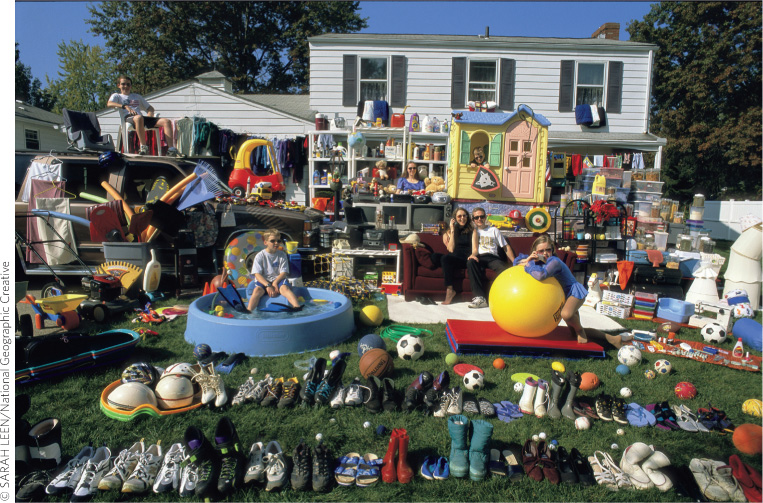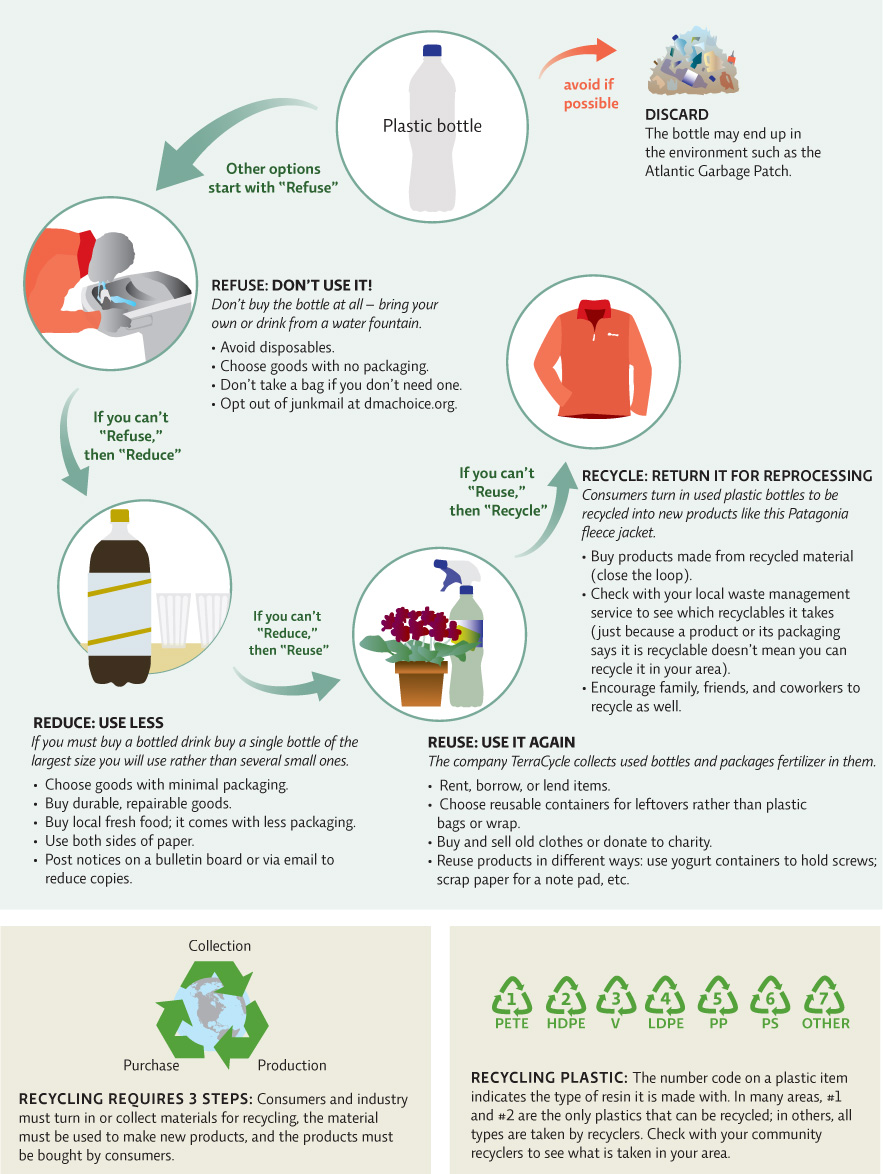Consumers have a role to play, too.
Advertising—a virtual staple of advanced societies—bombards us from every corner of modern life: not just on the televisions in our living rooms but on taxicab computer screens, billboard-laden subway cars, and the pop-up ads that invade our laptops. The message is surprisingly uniform: To live a happy, more fulfilling life, we simply must have more “stuff.” A good deal of that stuff—though certainly not all of it—is made of plastic. “Plastics are incredibly useful and have made possible many of the greatest breakthroughs in technology and standard of living,” Proskurowski says. “But they have also made our lives lazier. We now buy a bottle of water rather than refill a canteen. We buy individually wrapped bags of mini carrots, instead of buying carrots that are straight from the ground and have to be washed. There are countless other examples, and as we learn with every net tow, there are significant costs to the planet for those choices.”

KEY CONCEPT 7.8
Consumers can follow the four Rs to reduce their use of resources and generation of waste. This requires that we consider the reuse and recycling potential of any product before we decide to buy it and that we help “close the loop” by purchasing recycled products.
So how do we start making different choices? As any good environmentalist will tell you, it comes down to the “four Rs”: refuse, reduce, reuse, recycle.
The first thing we can do is simply refuse to use things that we don’t really need, especially if they are harmful to the environment. This may be as minor as declining to take a plastic bag for a few items purchased at the drugstore or as major as biking or walking to work rather than taking the car. The logic is simple: When we save a resource by refusing to use it, that resource lasts longer, which in turn means that less pollution will be generated disposing of it and producing replacements, and more will be available for future uses. “Refusal doesn’t mean never using the resource,” says David Bruno, founder of the 100 Thing Challenge, a popular movement to pare down our worldly possession to 100 items or fewer. “It just means using it at a more sustainable rate.”
refuse
The first of the waste-reduction four Rs. Choose not to use or buy a product if you can do without it.
If we can’t completely refuse a given commodity, we can still try to reduce our consumption of it or minimize our overall ecological footprint by making careful purchases. People who must drive to work can minimize their fossil fuel consumption by choosing a more fuel-efficient vehicle. Those who choose not to drink tap water might purchase a specialized faucet or pitcher filter instead of relying on bottled water. And all consumers can greatly reduce the amount of waste they generate by paying special attention to packaging, which accounts for one-third of all U.S. trash and roughly half of all paper used.
reduce
The second of the waste-reduction four Rs: Make choices that allow you to use less of a resource by, for instance, purchasing durable goods that will last or can be repaired.
And if we can’t avoid using a product, our next best choice is to reuse—the third R— something consumers can do with just a little effort, by choosing durable products over disposable ones. “Products produced for limited use are really just made to be trash,” Bruno says. “They pull resources out of the environment and produce pollution at every step of production, shipping, and disposal.” He advises considering use and reuse each time we head to the store. Whether you are purchasing clothing, razors, cups, or plates, ask yourself: How long will this last, and for what other purpose might it be used?
reuse
The third of the waste-reduction four Rs: Use a product more than once for its original purpose or for another purpose.
Reusing also applies to industry. TerraCycle is a U.S. company that produces liquid worm-compost fertilizer and packages it in used soda and water bottles. The company also collects hard-to-recycle packaging like candy bar wrappers and juice pouches and turns them into new products like backpacks.
Once we’ve refused, reduced, and/or reused a given commodity as much as possible, we are left with the final R, recycling, the reprocessing of waste into new products. Recycling has several advantages. It certainly reduces the trash we generate, but it does more than that. By reclaiming raw materials from an item that we can no longer use, we limit the amount of raw materials that must be harvested, mined, or cut down to make new items. In most cases, this helps conserve limited resources—not only trees and precious metals but also energy and water. To execute this step properly, we must first have purchased items that can be recycled. We must also close the loop by purchasing items that are made of recycled materials to encourage manufacturers to make products from recycled materials. INFOGRAPHIC 7.8
recycle
The fourth of the waste-reduction four Rs: Return items for reprocessing into new products.
There are ways to reduce the amount of waste we generate, but for the waste we do have, there are better options than simply throwing away many products. An item like a plastic bottle can be recovered and reused, as the innovative company TerraCycle does, or the bottle may be recycled into another product.


Why is “recycling” considered the fourth choice of the four Rs?
Recycling still requires energy, water and other resources. If a glass bottle, for example, were washed and reused, much less energy and water would be needed than if the bottle was recycled (ground down, melted, re-blown to produce a new bottle, etc.)
Of course, even recycling comes with trade-offs. For example, while less energy and water are used by making paper from paper than are used by making paper from trees, there are also energy and environmental costs in collecting used paper, storing it, and shipping it to recycling plants. Once these costs are factored in, sustainably harvesting a forest of fast-growing trees may prove to be more environmentally friendly than recycling used paper.
By journey’s end, the crew of the Corwith Cramer had spent a total of 34 days at sea, traveled 3,817 nautical miles (that’s about 7,000 km or 4,400 miles), conducted 128 net tows, and counted 48,571 pieces of plastic along the way. Crew members found the northern and southern boundaries of the Atlantic Patch, at latitudes near Virginia and Cuba, respectively. But despite making it as far as the Mid-Atlantic Ridge, they never found the eastern edge.
As the coast of Bermuda came back into view on July 14, 2010, Proskurowski wrote his last blog post:
It is easy to brush off the topic of plastic pollution in the ocean. It occurs thousands of miles from land, in regions of the planet that are rarely visited by humans, and relatively sparsely populated by marine life. It is also easy to pass off responsibility, to say “I recycle,”or “It must come from some other (developing) country,” or “It is all fishing or marine industry waste.” While there may be kernels of truth in all those arguments, the reality of the situation is that open ocean plastic pollution occurs over incredibly large regions of the Earth, has widely distributed point sources, and—because the oceans connect the whole globe—has far-reaching consequences.
Select References:
Environmental Protection Agency. (2014). Municipal Solid Waste Generation, Recycling, and Disposal in the United State: Facts and Figures for 2012 (EPA 530-R-14-001).
Hoornweg, D., & P. Bhada-Tata. (2012). “What a Waste: A Global Review of Solid Waste Management,” Urban Development Knowledge Papers, World Bank, http://www.worldbank.org/.
United Nations Environmental Programme. (2011). Plastic debris in the ocean. UNEP Yearbook 2011, www.unep.org/yearbook/2011/.
Webb, H. K., et al. (2012). Plastic degradation and its environmental implications with special reference to poly (ethylene terephthalate). Polymers, 5(1): 1–18.
Young, L. C., et al. (2009). Bringing home the trash: Do colony-based differences in foraging distribution lead to increased plastic ingestion in Laysan Albatrosses? PLoS ONE, 4(10): e7623.
PERSONAL CHOICES THAT HELP
How much solid waste you produce is under your control. By reducing the amount of waste you produce, you reduce how much money we spend on waste disposal as a whole and at the same time place less pressure on the resources used to produce consumer goods. Reducing your solid waste is very easy and can save you money in the process.
Individual Steps
•Track your trash. Record what you throw out for a week by category and weight. How could you reduce your total trash weight by one-quarter? By half?
•Use the information in Infographic 7.8 (strategies to refuse, reduce, reuse, and recycle) to identify five changes you can make to reduce your solid waste.
Group Action
•Start recycling unusual items in your community. TerraCycle is a company that takes items that usually end up in the garbage, like candy wrappers, corks, and chip bags, and recycles them into new products, like purses or backpacks.
•Talk to friends and family about having “no gift” or “low gift” celebrations. Instead of buying lots of presents, treat friends to a dinner or a fun activity. For large families, use a grab bag or draw names and buy or upcycle (give used goods) for only specific people.
Policy Change
•Talk to community leaders to discuss the possibility of starting a communitywide composting program.
•Research rates of recycling participation in your community. Advocate for recycling education and curbside recycling programs.